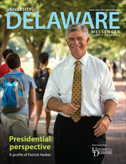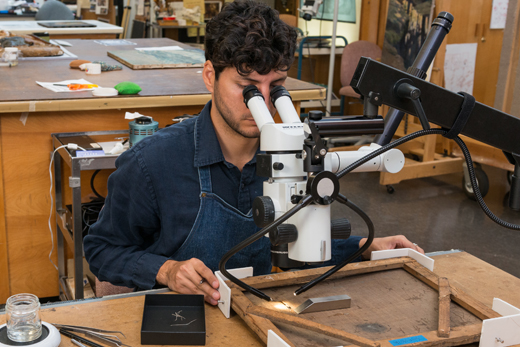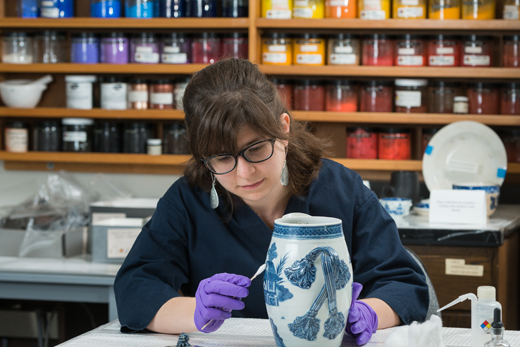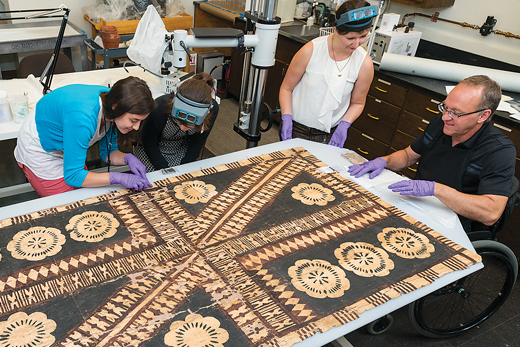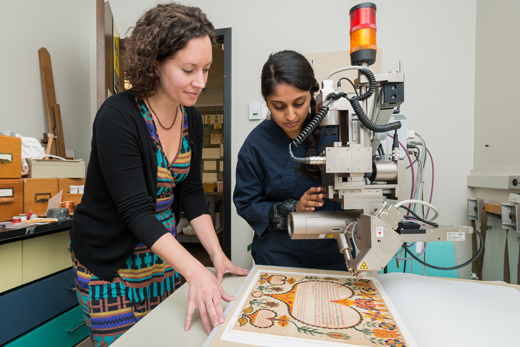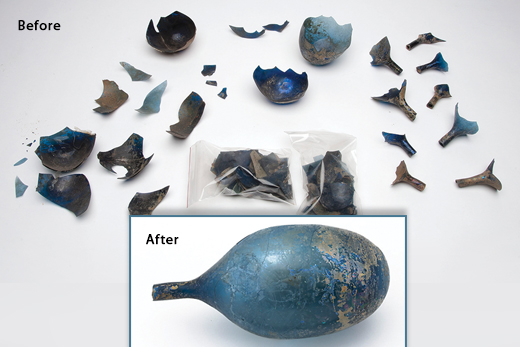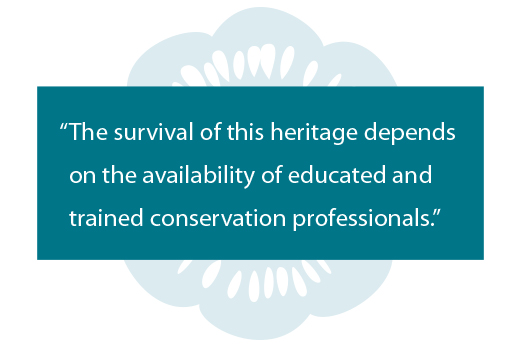Preserving the priceless
Conservationists protect our cultural heritage


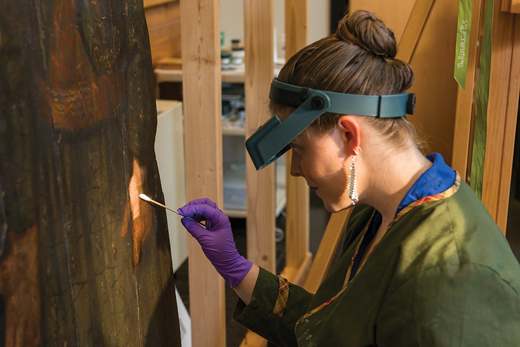
The U.S. Constitution, Gandhi’s cotton shawl, the original R2D2 from Star Wars, Elvis Presley’s 81 gold records and Picasso’s “Demoiselles d’Avignon” have a common link—the Winterthur/University of Delaware Program in Art Conservation.
All were preserved and restored by graduates of the esteemed program known as WUDPAC, which for 40 years has enabled students and alumni to salvage some of the most important markers of global cultural and artistic heritage.
WUDPAC, a three-year program whose students earn a master’s degree, is one of only five graduate programs in art conservation in North America and one of only two jointly sponsored between a university and a museum.
Each year, the University receives nearly 100 applications for the program’s 10 positions. Prerequisites include extensive coursework in chemistry, studio art, art history and anthropology and at least 400 hours of conservation experience.
“In return, we give them the practical experience, critical-thinking skills and experience in public and global engagement they’ll need to be successful in the field, now and in the future,” says Debra Hess Norris, AS77, 80M, Unidel Henry Francis du Pont Chair in Fine Arts and chairperson of the art conservation department.
Norris is herself a graduate of the program and an internationally recognized expert in the conservation of photographs.
UD offers preservation degrees at the undergraduate and doctoral levels, in addition to the WUDPAC master’s degree program.
As a field, art conservation is dedicated to preserving cultural property for future generations. Such property is threatened by repeated exposure to a variety of detrimental factors, including excessive light, temperature and humidity extremes, pests, pollutants, poor handling practices, natural disasters and accidental damage.
“The survival of this heritage depends on the availability of educated and trained conservation professionals,” Norris says.
The WUDPAC curriculum is designed to educate and train conservation professionals who can carry out the examination, analysis, stabilization and treatment of art and artifacts, speak to general principles of collection care and have a broad academic background in science and the humanities. Students learn from 17 conservators and conservation scientists and receive extensive hands-on experience through national and international internships.
With specialties in areas such as paintings, furniture or textiles, WUDPAC students have taken part in summer and third-year internship experiences around the world, working recently with objects ranging from a Tyrannosaurus rex skeleton being shipped from Montana to Washington, D.C., to an 18th-century illuminated Persian manuscript exhibited at the Library of Congress.
A global impact
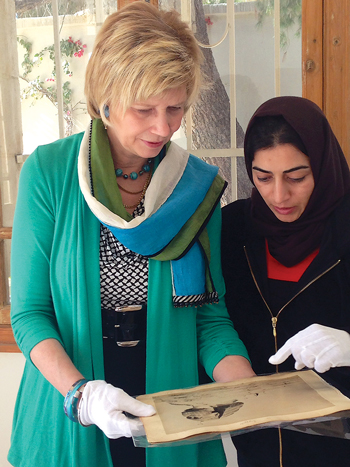
Art conservation programs at UD involve not only the education of students and future professionals but also outreach across the United States and around the world.
Undergraduate students, for example, have participated in a study abroad program at the Universite de Tarapacá in Arica, Chile, where they helped prepare pre-Inca textiles for a traveling exhibit. Graduate students regularly share their experiences with the public through blogs and other outreach activities.
The Department of Art Conservation is partnering with colleagues from Tsinghua University in Beijing to conduct a survey, analysis and assessment of 10th-century temple murals.
At the invitation of the U.S. State Department, UD has been a leading partner in the Iraqi Institute for the Conservation of Antiquities and Heritage in Erbil, where museum professionals from throughout Iraq have learned new ways to preserve their nation’s history and archaeology.
Workshops led by art conservation faculty members are held across the globe, from South Africa to Lebanon, and on the UD campus for specialized groups of professionals and students from other institutions. And once a month, students and faculty members hold a clinic in which they offer advice to the public about conservation issues.
Preserving the world’s photos
The University is continuing an initiative that seeks to improve the awareness and preservation of the Middle East region’s rich photographic heritage.
The Middle East Photograph Preservation Initiative (MEPPI), which was launched in 2011 after a successful pilot in 2009, is led by the Arab Image Foundation in Lebanon and by UD, the Getty Conservation Institute and the Metropolitan Museum of Art in the United States. The strategic initiative works to identify significant photograph collections, provide basic preservation training and build a strong network of conservation professionals.
Since it began, the project has provided training for 54 institutions and collections in 16 countries and territories, helping to preserve more than 15 million photographs, says Debra Hess Norris, AS77, 81M, Unidel Henry Francis du Pont Chair in Fine Arts and chairperson of the Department of Art Conservation, who teaches MEPPI sessions.
A new Andrew W. Mellon Foundation grant will extend the program through June 2017.
“At a time when many countries in the region are subject to political crises and extreme economic challenges, this training and advocacy are urgent,” Norris says. “Our work in photograph preservation engages communities, builds cultural identity and promotes reconciliation.”
Participants in the program have included professionals who are responsible for the care of photographic holdings in national archives and libraries, ministries, universities, museums and private repositories.
From 2011-14, MEPPI workshops were held in Lebanon, Morocco, the United Arab Emirates, Turkey and Jordan, covering such topics as storage of photographs, best practices for digitization, and emergency preparedness and response. Workshops were followed by distance mentoring and then by a follow-up meeting for participants to discuss their experiences, problems and progress.
Not-so-Old Masters
In an art conservation lab in Old College last August, they were painting like it was 1399.
Hard at work was a select group of art educators, curators and scholars from throughout the United States who took part in an intensive, weeklong workshop sponsored by the Samuel H. Kress Foundation and organized and taught by UD’s Department of Art Conservation.
The program was designed to give today’s professionals hands-on experience in using the same types of materials and techniques as traditional Italian painters of the late 14th and early 15th centuries. In addition to an appreciation for how such artists worked, the participants left the workshop with a piece they created and will use in educating others about traditional painting methods.
The 12 professionals invited to attend the workshop spent some long days in one of the campus conservation laboratories, involved in the painstaking process of creating a replica of a piece of art, titled “St. Romuald,” by Lorenzo Monaco (1372-1424).
“I definitely have more appreciation for this process than I did before,” said Elizabeth Gallerani, of the Williams College Museum of Art, as she experimented with different mixes of pigment and egg yolk to get the precise color she needed for her egg tempera painting. “I won’t ever look at this [kind of art] the same way again.”
The process included preparing a wood panel to create a white base and applying fragile gold leaf.
Workshop draws students from across U.S.
For students from 10 historically black colleges and universities who took part in a seven-day preservation workshop at the University of Delaware two summers ago, a picture might really seem to be worth a thousand words of history.
The hands-on program, led by art conservation faculty members Norris and Jae Gutierrez, gave the students training and practice in preservation techniques. All returned to their institutions to assist with work on photo collections there.
“Their colleges and universities have very important collections of significant historical value,” says Norris. “And, like all smaller institutions, they can benefit from preservation assistance. The students in the workshop gained not just knowledge and skills but also awareness of how important it is to preserve these materials.”
A similar workshop is scheduled for June 2015.
Students in the workshop learn to examine old photos from a new point of view and an eye to how each item should be stored to prevent damage to the paper or finish. They learn the different types of photos that preceded today’s digital imagery—daguerreotypes, tintypes and Cyanotypes, for example—and create some of their own images using traditional processes on photographic paper.
Participants come from a variety of majors. Only some are considering careers in conservation or museum work, although the program can lead some to new paths.
An alumna of a similar UD summer program, for example, is pursuing a career in the conservation field. Shannon Brogdon-Grantham was an undergraduate art history major at Spelman College when she attended two Arts and Humanities Summer Institutes at UD. She now is a third-year student in WUDPAC.
“In the summer of 2008, I had a casual conversation with Jae [Gutierrez] about the job of conservator, and that turned out to be a defining moment for me,” Brogdon-Grantham says. “I thought: This sounds like a career for me.”
